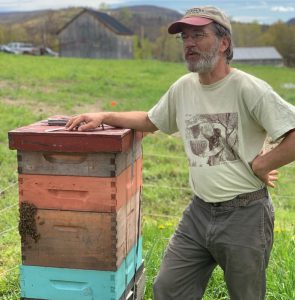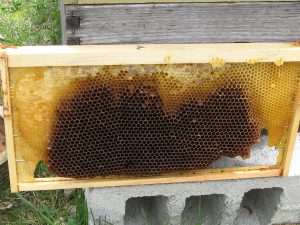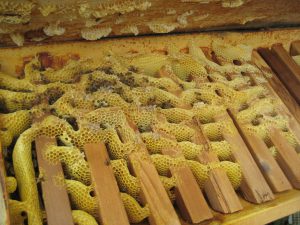 The Art and Science of Supering
The Art and Science of Supering
Ross Conrad
Of all the creatures on earth, the honey bee is the only one (other than humans) that will take a lot more than it needs from the world around them. Their hoarding instinct is so strong that as long as there is room in their hive and nectar is available to forage on, European honey bees will keep collecting and storing nectar as honey even after they have gathered more than enough to last them through a Winter dearth. Beekeepers exploit this trait of the honey bee to produce harvestable honey crops.
Observe honey bees in temperate climates and you will see that during the active foraging season, colonies have a strong tendency to store the majority of the honey they collect above the brood nest. The honey is positioned above since it provides the easiest and most convenient access during a period of dearth, especially during cold weather.
When honey is stored on either side of the brood nest with comb positioned between the cluster and their food source, cold temperatures can prevent the bees from reaching their honey. With honey overhead, bees simply move up utilizing the bee space between comb to reach their stored carbohydrates.
Positioning the bulk of their honey above the brood area also allows the residual heat that the cluster emits to pre-warm the honey slowing down the crystallization and hardening process, making the honey easier to use. This natural inclination of the honey bee has led to several styles of bee hive, designed that allow beekeepers to add additional space vertically, providing room for colony growth and expansion when needed.
The honey super
One reason for the wide adoption of the Langstroth hive is the ease with which beekeepers can supply additional boxes to their hives for bees to store their surplus honey. We call these boxes “supers” because they are placed in a location superior to (above) the brood nest.
For efficiency, commercial operations will often use deep boxes for both hive bodies and supers. The use of deep honey supers increases labor efficiencies when it comes to transporting and extracting the honey. Most backyard beekeepers use honey supers of shallow or medium depth since the majority of them, (and even some sideline and commercial beekeepers) feel that deep boxes filled with honey are too heavy to handle, especially without mechanical assistance.
Benefits of supering
While the strength of the colony is the most important influencing factor for maximizing honey production, the ability to increase the available storage space in a hive allows a colony, no matter what their size, to maximize their foraging potential and store all the nectar that they can gather. This helps to ensure an adequate honey supply for the colony during periods of dearth. Should the total amount of honey exceed the colonies needs, the beekeeper may take this excess for themselves in return for their stewardship. While the strongest hives will make the most honey, some research suggests that the work required to manage for large colonies is not always the most profitable approach (Neupane et. al., 2012).
Supering colonies that are running out of storage space above the brood nest helps prevent the workers from storing incoming nectar in the brood nest area which leads to a condition where the queen becomes honey bound. By preventing such congestion in the brood area, supering helps to discourage swarming: not that swarming (honey bee reproduction) is a bad thing. The more honey bee colonies in the world the better. It must be acknowledged however, that not only does swarming significantly reduce a colonies ability to gather honey, but as with most creatures, the reproduction process presents inherent risks to survival. If the colony is unsuccessful in raising a new queen, or the queen they raise fails to successfully mate and find her way back to the hive, the hopelessly queenless condition the colony finds itself in will be a death sentence without timely intervention on the part of the beekeeper.
Inspecting a hive for the need to add more space in the form of additional supers also acts as a quick check on the colony’s health and well-being. Depending on the location and time of year, a colony that does not store and cap excess honey in the hive over a few weeks, or during a time when plenty of nectar bearing plants are in bloom and agreeable weather conditions to forage exist, may be an indication that something is wrong with the hive and a closer inspection is warranted. This is why having more than one colony can be so helpful. If one hive is filling up and adding lots of new white wax to the combs while the other is not, this provides a red flag that the slower developing colony may be in need of beekeeper assistance.
Drawn comb or foundation?
Often the supering options available to a beekeeper are limited to whatever is on hand. If given a choice, I only super with foundation at the start of a major honey flow and only when the majority of the existing combs in the hive are already full and in use. A sign that the colony’s storage space is running out and foundation is an appropriate choice is the appearance of burr comb between the inner cover and the top bars.

While honey bees will store some of their honey in and to the side of the brood area, they prefer to store most of their surplus honey above the brood area. The dark comb on this frame indicates the comb used for brood rearing, while the lighter colored comb was only used for honey and pollen storage.
Foundation is also a good choice when hiving a newly captured swarm. Since many of the young workers within the swarm will have engorged themselves on honey prior to leaving their old hive, they will be primed to produce new comb and will draw out foundation quickly if it is provided in their new nesting site.
Supering with fully drawn out comb is best when the hive is starting to run out of room but no major honey flow is expected. While there may not be enough nectar flow to stimulate comb building, the bees will have ample room to store the honey that does trickle in. Using drawn comb also allows the colony to maximize its honey production potential since precious carbohydrates and not consumed to create beeswax for comb building.
Another way to maximize production is to remove a frame or two from each super of drawn comb and space out the remaining combs equally. When using foundation it is best to fill supers all the way however, otherwise the additional space created by the missing frame(s), combined with the space created by the this sheets of foundation, usually results in cross comb construction that is messy and difficult to deal with.
Some beekeepers will mix frames of drawn comb and foundation in a single box. Filling every other slot with a frame of foundation helps ensure that the bees build new comb that is straight. Unfortunately, since the bees will fill the drawn comb quicker than the foundation, it will result in the previously built combs being drawn out significantly wider than the frames of foundation. These extra fat frames are often difficult to remove without crushing honey comb and squashing bees and they become problematic when they are moved around in the hive or used to replace combs in other hives.
Timing
To enjoy the full benefits of supering, close attention should be paid to the timing of when additional room is added to a hive. It is astonishing how quickly a well populated colony can fill a honey super during a strong nectar flow. This is why making a quick inspection every 7-10 days during a flow is normally suggested. Besides timing supering to take full advantage of nectar flows, consideration must be given to when supers need to be removed in order to apply any planned treatments. Sometimes a colony will be running out of room, but since it is not too much longer before treatments will be applied, it is best to just let the bees finish packing in the honey and filling the hive to capacity.
Ideally supers are added before the colony starts running out of room especially around the start of a nectar flow. Add supers too late, after the queen has become honey bound and the colony may have already decided to swarm. If empty drawn comb is provided too early it may tax the colony with so much additional cleaning, patrolling and protecting duties that it undermines the health of the colony. This is especially true if the hive is not strong.
How many?
In places with long cold Winters, it’s generally best to generally add supers one at a time with subsequent supers added only when the current space in the hive is approaching 75-80 percent capacity. My ideal time to super is when the center frames are mostly all full and the bees are just starting to work on the outer two frames in the top super.
Add supers earlier and the bees tend to start immediately working in the upper super and ignore the frames along the outside walls in the super below. This leads to a chimney effect where the hive’s center frames are all full and the outer frames mostly empty.

The colony housed in this top-bar hive was not given drawn comb, but only provided with top bars that were spaced too far apart. Without spacial cues to guide them, the bees built beautiful comb that unfortunately does not lend itself to easy inspection by a beekeeper. Supering hives with drawn comb, or foundation or starter strips spaced close together would have resulted in combs that were built much straighter and more in line with the top bars.
In order to avoid having to feed bees in Winter, this means that the beekeeper must now either race against the weather to feed copious amounts of sugar syrup so the bees can fill up the outer frames of the honey supers, or manually replace all the unfilled frames with frames of capped honey in order to ensure adequate Winter supplies. Either way is a lot of extra work, work that I prefer to avoid by only supering when a hive is already storing honey in the outer most frames.
Adding a single super at a time is especially important in the case of foundation. Adding more than a single super of foundation provides an opportunity for house bees to damage the foundation by chewing at the edges before the wax producers have the opportunity to build comb upon it. Researchers have also found that colonies receiving more than one super of foundation at a time can experience decreased overall honey production and a suppressed immune response (Kadri et. al., 2022).
The reality of course is that today’s busy lifestyles do not always allow for regular 7-10 day visits to the beeyard to check the status of hive space to see if additional supers are needed. If it will be a month or more before another inspection is possible, one can super with two or three boxes of fully drawn comb. This is risky however and care must be taken to ensure that such colonies contain large enough populations to adequately patrol this extra expanse of comb and protect it from pests such as wax moths and small hive beetles. However you go about supering, be sure to have your supers all ready to go before you need them.
References:
Kadri, S.M., Ribolla, P.E.M., Alonso, D.P., de Jong, D., de Oliveira Orsi, R. (2022) Supering Apis mellifera (Hymenoptera, Apidae) beehives impairs honey production and biomarker genes, Scientia Agricola, 79(2)
Neupane, K.R., Woyke, J., Wilde, J. (2012) Effect of initial strength of honey bee colonies (Apis mellifera) supered in different ways on maximizing honey production in Nepal, Journal of Apicultural Science, 56(2):71-81











